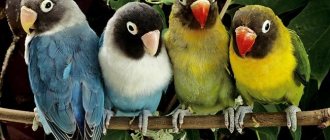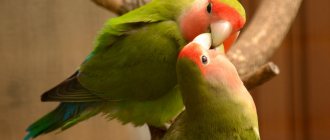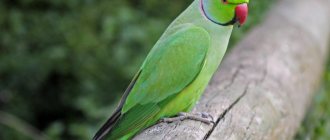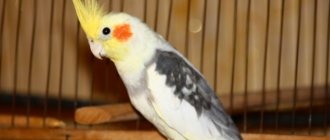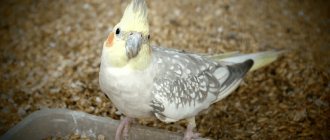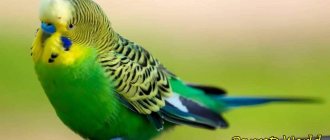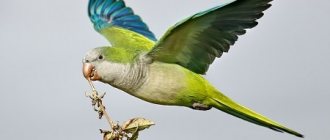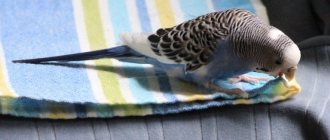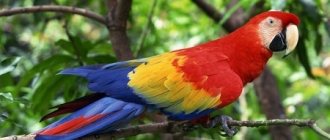The desire to pamper your feathered friends with some special treat is a completely normal desire. The main thing is not to overdo it in pampering your pets and not to feed them something harmful or unsafe for the bird’s health.
Or you can do it yourself, the main thing is to develop your imagination and have suitable products on hand. Such a treat will be fresh and will only benefit your pet.
This type of food should not be abused; it is better to perceive it as a vitamin supplement to the bird’s main food or encouragement during training and training.
If you treat your parrot too often, he may simply refuse the main food and will wait for the long-awaited “candy”.
You can feed our birds with treats no more than 1-2 times a week. On other days, birds should have a standard, nutritious diet.
Photo: webandi
What you should pay attention to when buying store-bought treats:
- it should not be a poisonous color - dyes do not improve the quality of the product, but only attract the buyer’s attention;
- the presence of additional flavoring additives and preservatives is dangerous to the health of the parrot;
- if the composition includes fats, sugar, baking products and nuts, it is better not to take such a product;
- study the composition and quality of grains - most high-calorie seeds can lead to disruption of the liver and gastrointestinal tract, which will lead to obesity and other troubles. Also, unscrupulous manufacturers often use stale grains in delicacies, which leads to poisoning of birds;
- packaging, storage and shelf life are important factors.
If any component does not inspire confidence in you, do not buy this delicacy.
What do budgies like?
The basis of the diet of budgerigars is a grain mixture of millet of various types (65%), oats (20%) and canary seed (10%), as well as other grains and seeds of cultivated and wild plants. It is useful to give parrots small quantities of flax, sesame, plantain, dandelion, sunflower and hemp seeds. However, by eating only one grain mixture, your parrot will not receive all the nutrients it needs to stay healthy. Therefore, the following is additionally introduced into the diet:
- fruits;
- berries;
- vegetables;
- greenery;
- porridge;
- sprouted grain;
- protein-rich animal feed.
Parrots love this food very much, so they can be used as a reward. Certain types of grains are also tasty for parrots - chumiza, sorghum, mogar, paisa and Senegalese millet. It is also useful to periodically let the birds chew on honey sticks, which are easy to prepare with your own hands.
Fruits and berries
Berries and fruits are given fresh. They should be free from mold, rot, dirt and damage. Before feeding, they must be washed with water. Some fruits must be peeled, which may contain toxic compounds used to protect the crop from pests.
Budgerigars love to eat: apples, pears, bananas, citrus fruits, plums, grapes, watermelon, kiwi, pineapple, pomegranate, peaches, apricots, cherries, cherries, rowan berries, sea buckthorn, honeysuckle, raspberries, currants, rose hips, strawberries, wild strawberries, blueberries , lingonberries, cranberries.
On a note! Berries dried at proper temperatures retain vitamins and can be stored for the winter.
Vegetables and greens
Greens and vegetables are also given fresh and washed thoroughly. To prevent your parrot from getting poisoned, you should feed only seasonal vegetables. Vegetables and greens contain a lot of fiber, vitamins and minerals. Vegetables are given to birds only raw, cut into pieces or grated. It is useful to feed parrots: carrots, turnips, beets, pumpkin, cucumbers, tomatoes, zucchini, cabbage, green peas, beans, sweet peppers. The birds are also given greens: lettuce, spinach, celery, chickweed, dandelion, nettle. Weeds can be collected in the summer, dried at the right temperatures and stored for the winter.
Honey sticks
Honey sticks are a favorite treat of budgies. To prepare them you will need:
- thin dry twigs of bushes and fruit trees or wooden Chinese sticks for the base;
- 1 tbsp. l. flour;
- 1 glass of water;
- 0.5 tsp. honey;
- sesame grains, millet, etc.
Honey is diluted in water and added to flour until it reaches a paste consistency. Coat the stick with the mixture, sprinkle with grain and leave to dry for 24 hours at room temperature. Pour honey diluted in water over the treat and dry it, after which it is given to the parrot. When exhausted, after heavy molting or illness, it is useful to feed the birds sticks that contain quail eggs.
Chumiza
Chumiza is a cereal crop whose inflorescences look like panicles and contain a large number of grains (about 6000 on one spikelet). The shape of the spikelets and the color of the grains depend on the variety. Chumiza is rich in protein, vitamins, minerals, macro and microelements, pectins, antioxidants, fiber, sugars, and fats. In terms of the content of nutrients, it is superior to rice, millet, buckwheat and barley.
Chumiza strengthens the immune system, improves the condition of the cardiovascular system, and removes toxins and heavy metal salts from the body. Parrots are very fond of chumiza, so it can be used for taming. They give chumiza 2-3 times a week.
Senegalese millet
Senegalese millet is similar in appearance to Chumiza, but has a different color. Senegalese millet grains are a uniform straw-yellow color, while Chumiza grains can be black, white, yellow and brown. Senegalese millet is rich in fiber, carotene, B vitamins, micro and macroelements, but contains less fat, protein and carbohydrates than chumiza.
Senegalese millet is a grain that parrots love. It is given to birds as a reward during training or taming. You can simply hang the spikelet from the bars of the cage so that the parrot can get the grain itself. Senegalese millet is given no more than 2-3 times a week.
Favorite treats
Dry food is the base, which makes up about 70% of the total diet of domesticated birds. The classic version is millet, oats and millet. But budgies eat canary seeds and sesame seeds with particular pleasure. For them it is a tasty delicacy.
Popular grain food for parrots:
millet;- canary seed;
- sunflower;
- oats;
- safflower;
- sesame;
- millet.
The taste preferences of all birds may differ. To find out which grains your pet prefers over others, you need to let him try a hodgepodge of several types.
The seeds eaten first can be called favorite.
In some cases, it is more practical to buy industrial feed. In addition, they contain a number of useful additives in the form of vitamins and minerals. Most often, this kind of food is combined, that is, it consists of several crops, for example, oats with millet or sesame with millet.
Budgerigars especially love food brands:
- "Padovan";
- RIO;
- Fiory;
- Versele-Laga.
When purchasing, it is better to give preference to solutions marked “For small parrots.” Feeds intended for large birds are often diluted with nuts and seeds. Budgies can choke on these additives.
Fruits, vegetables and berries
Fruits and vegetables can be given to birds and should definitely be included in your budgie's diet. If you feed your pet only grains, then his body will begin to malfunction, which is reflected in constipation, apathy and poor health in general.
It has been noticed that budgies especially love bananas, apricots and cucumbers. They are also delighted with melon and cherries. In some cases, finding out which treat your pet likes can only be done experimentally. That is, let him try all the allowed products.
Parrots can be given the following fruits, vegetables and berries:
apricot;- apple;
- peach;
- grape;
- a pineapple;
- melon;
- banana;
- mandarin;
- pear;
- cherries;
- rose hip;
- orange.
If a bird flatly refuses to eat fruits and vegetables, then it needs to be convinced otherwise. You can use some tricks. For example, add pieces of fruit to porridge or dry food. The next time you try to treat the parrot, he will no longer resist so much, having recognized the familiar smell and taste.
You should also use special fruit holders . They cannot be placed on a pallet in a cage. Products, mixed with feathers and droppings, quickly rot, turning into a breeding ground for parasites. If the fruits are on the holder in the morning, then by evening they should be removed.
Porridge
All domesticated birds and budgies also love to eat porridge. They are tasty, healthy and much easier to digest than dry food. It is impossible to identify specific types of cereals that budgies prefer. Because here everything depends on the pet itself. But in any case, you should try to treat the bird with porridge.
Budgerigars love:
- buckwheat porridge;
- rice;
- barley;
- millet;
- pearl barley;
- oatmeal
Porridge must be cooked in distilled water. It is unacceptable to add sugar, salt and spices. Before serving, the porridge should be cooled to room temperature.
Some parrots like combined options consisting of several grains. You can also add grated fruits, vegetables or berries to the porridge. For budgies, it is better to cook the cereal until it has a viscous consistency, rather than serving it crumbly. The animal's small stomach accepts the first option much more readily.
Juices
In addition to water, juices can serve as a source of liquid. Budgerigars are very fond of squeezed apples, pears and citrus fruits. If you don’t want to process fruits, you can use baby juices. The only thing is that the latter should not contain sugar.
ordinary solutions, like “Kind” or “Favorite Garden” for birds . They contain a lot of dyes, stabilizers and other chemicals. You also need to remember that juices are a perishable product. They should stay in the cage for no more than a day.
What not to give
Not all foods are good for parrots. Birds should not be given:
- parsley, dill and other spices;
- onion and garlic;
- eggplant;
- mango;
- avocado;
- persimmon;
- papaya;
- chocolate;
- nuts in large quantities;
- fresh bread and pastries;
- meat and fish;
- milk and dairy products (except low-fat cottage cheese);
- salted, smoked, sweet, fried and boiled foods from the human table;
- alcohol, coffee.
Some of these products (for example, chocolate) pose a mortal danger to birds, so during walks you need to make sure that the parrot does not steal food that is inappropriate for it from the table.
When and how much to feed your parrot
One bird should receive two teaspoons of dry food per day. Some people are gluttonous and demand much more. Be sure to monitor the amount of food consumed, as budgies are prone to obesity. It is recommended to divide the daily dose and give it to the birds in portions. Do not allow the resident to eat more than three tablespoons of the grain mixture.
Carefully. Small birds have an accelerated metabolism. Lack of food can lead to negative consequences and even death. You can purchase an automatic feeder for serving food in portions.
Sprouted seeds
In addition to granulated food, we feed our parrots with foods containing vitamins. Their source is wheat germ. Seeds can be germinated at home. A handful of grains are washed and placed on cheesecloth in a bowl. Then add water, place in a warm place, and rinse every six hours. The next day the precious delicacy will be ready. Germinating grains are necessary for birds during the mating period and during the raising of chicks.
Vitamins and mineral supplements
The content of vitamins and minerals in the feed cannot satisfy all the needs of the bird. They especially need them during the molting period.
You can buy vitamins and supplements at a pet store or prepare them yourself: add three drops of honey to 100 ml of water, the same amount of lemon juice and 1 ml of apple cider vinegar. Pour the resulting measure into the drinking bowl.
Vegetables and fruits
Vegetables and fruits are a valuable source of vitamins. Seeds and grains are not all plant foods that parrots eat. A healthy treat is grated carrots with chopped croutons.
Cabbage leaves and cores can also be fed to parrots. Before eating, cabbage should be finely chopped. Beans, green peas and corn can be part of your diet. When purchasing, give preference to unripe flasks with soft grains.
Carefully. Peeled apples should be fed to your pet all year round. This is the only fruit that can be eaten without harm to health.
What else can you feed lovebirds besides food:
Small portions of pears and citrus fruits are also good for birds. In addition, birds are not averse to eating raspberries, blueberries, rose hips and currants.
Cereal porridge is what you can feed your parrot if he runs out of food. They are prepared using water, without adding sugar or salt. Cereals contain essential microelements that normalize metabolism.
Oatmeal when feeding parrots can be of any consistency, but only at room temperature. If desired, you can add grated fruit to it. The finished product can be stored in the refrigerator for no more than two days.
Greenery and branches
Green food will enrich your feathered pet's diet. Greens are something that parrots eat with particular pleasure. It is recommended to collect green mass away from roads and industrial enterprises.
Birds need to sharpen their beaks. Wallpaper often becomes the object of their attention. An alternative option is tree branches that can be used to feed parrots after initial treatment. They are placed in cold water for five hours and then placed in boiling water.
Before feeding your parrot, make sure there are no resin drops from the tree.
Poplar, lilac, oak and pear branches are dangerous. A bird can be poisoned by a houseplant. Sometimes birds explore the apartment and taste the green leaves of flowers.
Attention! It is better to move ferns, dieffenbachia, chlorophytum and azaleas to another room. Tradescantia, rose, aloe, chrysanthemum and bamboo are safe.
Water should be served in small portions. It should always be fresh. Do not pour tap water into the drinking bowl. Bottled baby lotion or filtered water is much safer.


